Flexural Performance of RC Beams Strengthened with Pre-Stressed Iron-Based Shape Memory Alloy (Fe-SMA) Bars: Numerical Study
Abstract
:1. Introduction
2. Background and Literature
3. Finite Element Simulation
3.1. Beam Geometry Used in Verification
3.2. Constitutive Model for Concrete in ABAQUS
3.3. Reinforcement Definition in ABAQUS
3.4. RC Beam Modeling in ABAQUS
3.4.1. Elements and Meshing
3.4.2. Pre-Stressing Modeling
4. Parametric Study
5. Results and Discussion
5.1. Verification Models
5.2. Parametric Study
5.2.1. Effect of Pre-Stressing Level
5.2.2. Effect of Changing Fe-SMA Rebar’s Diameter
5.2.3. Effect of Concrete Grade
5.2.4. Effect of Varying Strengthening Rebar Types
6. Conclusions
- Increasing either the pre-stressing level of Fe-SMA bars or the concrete grade enhanced the beam’s response at the serviceability stage but exhibited a minor effect at the ultimate stage. Specifically, increasing the concrete grade from 30 to 60 MPa produces a 15%, 4%, and 0.75% rise in the cracking, steel yielding, and ultimate loads, respectively, for the test specimens.
- Using a larger diameter of Fe-SMA bars improved the load-carrying capacity but reduced the ductility of test specimens. Specifically, using 12 mm Fe-SMA bars instead of 6 mm increased the beam’s strength by 73% and decreased the ductility by 14%.
- Strengthening RC beams with 2T22 mm of pre-stressed Fe-SMA bars yielded a better strength and ductility response than other commonly used techniques with 2T12 mm of carbon fiber reinforced polymer (CFRP) bars, glass fiber reinforced polymer (GFRP) bars, and steel strands. Moreover, considering the fabrication cost, the Fe-SMA rebars exhibited a comparable cost to other pre-stressing systems.
- Further experimental tests are required to further ascertain the reported findings of this numerical investigation. In particular, it is recommended to explore the use of the Fe-SMA bars as the main reinforcement in future research.
Author Contributions
Funding
Data Availability Statement
Acknowledgments
Conflicts of Interest
References
- Aksoylu, C.; Özkılıç, Y.O.; Arslan, M.H. Mechanical Steel Stitches: An Innovative Approach for Strengthening Shear Deficiency in Undamaged Reinforced Concrete Beams. Buildings 2022, 12, 1501. [Google Scholar] [CrossRef]
- Gemi, L.; Madenci, E.; Özkılıç, Y.O.; Yazman, S.; Safonov, A. Effect of Fiber Wrapping on Bending Behavior of Reinforced Concrete Filled Pultruded GFRP Composite Hybrid Beams. Polymers 2022, 14, 3740. [Google Scholar] [CrossRef] [PubMed]
- Khalil, A.; Etman EA, A.; Essam, M. Strengthening of RC Beams Subjected to Cyclic Load Using Ultra High Performance Strain Hardening Cementitious Composites. ISEC Press 2017, 4, 1–6. [Google Scholar] [CrossRef]
- Khalil, A.; Etman EA, A.; Essam, M. Behavior of RC beams strengthened with strain hardening cementitious composites (SHCC) subjected to monotonic and repeated loads. Eng. Struct. 2017, 140, 151–163. [Google Scholar] [CrossRef]
- Khalil, A.; Etman, E.A.A.; Atta, A.; Essam, M. Nonlinear behavior of RC beams strengthened with strain hardening cementitious composites subjected to monotonic and cyclic loads. Alex. Eng. J. 2016, 55, 1483–1496. [Google Scholar] [CrossRef]
- Peng, G.; Niu, D.; Hu, X.; Zhong, S.; Huang, D. Experimental and theoretical study on the flexural behavior of RC beams strengthened with cementitious grout. Eng. Struct. 2022, 267, 114713. [Google Scholar] [CrossRef]
- Hawileh, R.A. Nonlinear finite element modeling of RC beams strengthened with NSM FRP rods. Constr. Build. Mater. 2012, 27, 461–471. [Google Scholar] [CrossRef]
- Hawileh, R.A.; Naser, M.; Zaidan, W.; Rasheed, H.A. Modeling of insulated CFRP-strengthened reinforced concrete T-beam exposed to fire. Eng. Struct. 2019, 31, 3072–3079. [Google Scholar] [CrossRef]
- Hawileh, R.A.; Rasheed, H.A.; Abdalla, J.A.; Al-Tamimi, A.K. Behavior of reinforced concrete beams strengthened with externally bonded hybrid fiber reinforced polymer systems. Mater. Des. 2014, 53, 972–982. [Google Scholar] [CrossRef] [Green Version]
- Sun, Y.; Wu, T.; Liu, X. Design of concrete beams reinforced and unbonded pre-stressed with FRP bars based on serviceability requirements. Compos. Struct. 2022, 300, 116133. [Google Scholar] [CrossRef]
- Su, M.; Gong, S.; Liu, Y.; Peng, H. Flexural behavior of RC beams strengthened with fully or partially pre-stressed near-surface mounted FRP strips: An experimental investigation. Eng. Struct. 2022, 262, 114345. [Google Scholar] [CrossRef]
- Hakan, A.M.; Yazman, Ş.; Hamad, A.A.; Aksoylu, C.; Özkılıç, Y.O.; Gemi, L. Shear strengthening of reinforced concrete T-beams with anchored and non-anchored CFRP fabrics. Structures 2022, 39, 527–542. [Google Scholar]
- Gemi, L.; Alsdudi, M.; Aksoylu, C.; Yazman, Ş.; Özkılıç, Y.O.; Arslan, M.H. Optimum amount of CFRP for strengthening shear deficient reinforced concrete beams. Steel Compos. Struct. 2022. [Google Scholar] [CrossRef]
- Nie, X.F.; Zhang, S.S.; Teng, J.G. Strengths of RC beams with a fibre-reinforced polymer (FRP)-strengthened web opening. Compos. Struct. 2021, 258, 113380. [Google Scholar] [CrossRef]
- Najaf, E.; Orouji, M.; Ghouchani, K. Finite element analysis of the effect of type, Number, and Installation Angle of FRP Sheets on improving the Flexural Strength of Concrete Beams. Case Stud. Constr. Mater. 2022, 17, e01670. [Google Scholar] [CrossRef]
- Alhamaydeh, M.; Barakat, S.; Abed, F. Multiple Regression Modeling of Natural Rubber Seismic-Isolation Systems with Supplemental Viscous Damping for Near-Field Ground Motion. J. Civ. Eng. Manag. 2013, 19, 665–682. [Google Scholar] [CrossRef]
- Alhamaydeh, M.; Aly, N.; Galal, K. Seismic Response and Life-Cycle Cost of Reinforced Concrete Special Structural Wall Buildings in Dubai, UAE. Struct. Concr. 2018, 19, 771–782. [Google Scholar] [CrossRef]
- AlHamaydeh, M.; Orabi, M. Punching Shear Behavior of Synthetic Fiber-Reinforced Self-Consolidating Concrete Flat Slabs with GFRP Bars. J. Compos. Constr. ASCE 2021, 25, 04021029. [Google Scholar] [CrossRef]
- Hosseini, A.; Michels, J.; Izadi, M.; Ghafoori, E. A comparative study between Fe-SMA and CFRP reinforcements for pre-stressed strengthening of metallic structures. Constr. Build Mater. 2019, 26, 976–992. [Google Scholar] [CrossRef]
- Youssef, M.A.; Alam, M.S.; Nehdi, M. Experimental investigation on the seismic behavior of beam-column joints reinforced with superelastic shape memory alloys. J. Earthq. Eng. 2008, 12, 1205–1222. [Google Scholar] [CrossRef]
- Ghafoori, E.; Hosseini, A.; Michels, J.; Izadi, M.R.; Pellissier, E. Iron-Based Shape Memory Alloy (Fe-SMA) vs. CFRP for Pre-stressed Strengthening of Civil Metallic Structures. In Proceedings of the International Conference on Fibre-Reinforced Polymer (FRP) Composites in Civil Engineering, Istanbul, Turkey, 8–10 December 2021; pp. 2139–2153. [Google Scholar]
- Karbhari, V.M.; Chin, J.W.; Hunston, D.; Benmokrane, B. Durability gap analysis for fiber-reinforced polymer composites in civil infrastructure. J. Compos. Constr. 2003, 7, 238–247. [Google Scholar] [CrossRef]
- Lee, W.J.; Partovi-Nia, R.; Suter, T.; Leinenbach, C. Electrochemical characterization and corrosion behavior of an Fe-Mn-Si shape memory alloy in simulated concrete pore solutions. Mater. Corros. 2016, 67, 839–846. [Google Scholar] [CrossRef]
- Sidharth, R.; Abuzaid, W.; Vollmer, M.; Niendorf, T.; Sehitoglu, H. Fatigue crack initiation in the iron-based shape memory alloy FeMnAlNiTi. Shape Mem. Superelast. 2020, 6, 323–331. [Google Scholar] [CrossRef]
- Abouali, S.; Shahverdi, M.; Ghassemieh, M.; Motavalli, M. Nonlinear simulation of reinforced concrete beams retrofitted by near-surface mounted iron-based shape memory alloys. Eng. Struct. 2019, 187, 133–148. [Google Scholar] [CrossRef]
- Yeon, Y.-M.; Lee, W.; Hong, K.-N. Finite Element Analysis of Reinforced Concrete Beams Prestressed by Fe-Based Shape Memory Alloy Bars. Appl. Sci. 2022, 12, 3255. [Google Scholar] [CrossRef]
- Elkafrawy, M.E.; Khalil, A.M.; Abuzaid, W.; Hawileh, R.A.; AlHamaydeh, M. Nonlinear Finite Element Analysis (NLFEA) of Pre-stressed RC Beams Reinforced with Iron-Based Shape Memory Alloy (Fe-SMA). In Proceedings of the 2022 Advances in Science and Engineering Technology International Conferences (ASET), Dubai, United Arab Emirates, 21–24 February 2022; pp. 1–7. [Google Scholar]
- Smith, M. ABAQUS/Standard User’s Manual, Version 6.9; Dassault Systèmes Simulia Corp: Johnston, RI, USA, 2009. [Google Scholar]
- ASTM D790-07; Standard Test Methods for Flexural Properties of Unreinforced and Reinforced Plastics and Electrical Insulating Materials. ASTM International: West Conshohocken, PA, USA, 2007.
- Hafezolghorani, M.; Hejazi, F.; Vaghei, R.; Jaafar, M.S.b.; Karimzade, K. Simplified damage plasticity model for concrete. Struct. Eng. Int. 2017, 27, 68–78. [Google Scholar] [CrossRef]
- Shahverdi, M.; Czaderski, C.; Annen, P.; Motavalli, M. Strengthening of RC beams by iron-based shape memory alloy bars embedded in a shotcrete layer. Eng. Struct. 2016, 117, 263–273. [Google Scholar] [CrossRef]
- Ölander, A. An electrochemical investigation of solid cadmium-gold alloys. J. Am. Chem. Soc. 1932, 54, 3819–3833. [Google Scholar] [CrossRef]
- Furuya, Y. Design and material evaluation of shape memory composites. J. Intell. Mater. Syst. Struct. 1996, 7, 321–330. [Google Scholar] [CrossRef]
- Hartl, D.J.; Lagoudas, D.C. Aerospace applications of shape memory alloys. Proc. Inst. Mech. Eng. G J. Aerosp. Eng. 2007, 221, 535–552. [Google Scholar] [CrossRef] [Green Version]
- Bil, C.; Massey, K.; Abdullah, E.J. Wing morphing control with shape memory alloy actuators. J. Intell. Mater. Syst. Struct. 2013, 24, 879–898. [Google Scholar] [CrossRef]
- Sreekumar, M.; Nagarajan, T.; Singaperumal, M.; Zoppi, M.; Molfino, R. Critical review of current trends in shape memory alloy actuators for intelligent robots. Ind. Robot. Int. J. 2007, 34, 285–294. [Google Scholar] [CrossRef]
- Kheirikhah, M.M.; Rabiee, S.; Edalat, M.E. A Review of Shape Memory Alloy Actuators in Robotics BT—RoboCup 2010: Robot Soccer World Cup XIV; Ruiz-del-Solar, J., Chown, E., Plöger, P.G., Eds.; Springer: Berlin/Heidelberg, Germany, 2011; pp. 206–217. [Google Scholar]
- Mantovani, D. Shape memory alloys: Properties and biomedical applications. Jom 2000, 52, 36–44. [Google Scholar]
- Janke, L.; Czaderski, C.; Motavalli, M.; Ruth, J. Applications of shape memory alloys in civil engineering structures—Overview, limits and new ideas. Mater. Struct. 2005, 38, 578–592. [Google Scholar]
- Czaderski, C.; Shahverdi, M.; Brönnimann, R.; Leinenbach, C.; Motavalli, M. Feasibility of iron-based shape memory alloy strips for pre-stressed strengthening of concrete structures. Constr. Build. Mater. 2014, 56, 94–105. [Google Scholar] [CrossRef]
- Abuzaid, W.; Wu, Y.; Sidharth, R.; Brenne, F.; Alkan, S.; Vollmer, M.; Sehitoglu, H. FeMnNiAl iron-based shape memory alloy: Promises and challenges. Shape Mem. Superelasticity 2019, 5, 263–277. [Google Scholar] [CrossRef]
- Schranz, B.; Czaderski, C.; Vogel, T.; Shahverdi, M. Bond investigations of pre-stressed, near-surface-mounted, ribbed memory-steel bars with full bond length. Mater. Des. 2020, 196, 109145. [Google Scholar] [CrossRef]
- Cladera, A.; Weber, B.; Leinenbach, C.; Czaderski, C.; Shahverdi, M.; Motavalli, M. Iron-based shape memory alloys for civil engineering structures: An overview. Constr. Build. Mater. 2014, 63, 281–293. [Google Scholar] [CrossRef]
- Ghafoori, E.; Neuenschwander, M.; Shahverdi, M.; Czaderski, C.; Fontana, M. Elevated temperature behavior of an iron-based shape memory alloy used for pre-stressed strengthening of civil structures. Constr. Build. Mater. 2019, 211, 437–452. [Google Scholar] [CrossRef]
- Michels, J.; Shahverdi, M.; Czaderski, C.; Schranz, B.; Motavalli, M. Iron based shape memory alloy strips, part 2: Flexural strengthening of RC beams. In Proceedings of the Fourth International Conference on Smart Monitoring, Assessment and Rehabilitation of Civil Structures (SMAR 2017), Zurich, Switzerland, 15 September 2017. [Google Scholar]
- Shahverdi, M.; Michels, J.; Czaderski, C.; Motavalli, M. Iron-based shape memory alloy strips for strengthening RC members: Material behavior and characterization. Constr. Build. Mater. 2018, 173, 586–599. [Google Scholar] [CrossRef]
- Yamauchi, K. Shape Memory and Superelastic Alloys: Technologies and Applications; Woodhead Publishing: Sawston, UK, 2011. [Google Scholar]
- Lee, W.J.; Weber, B.; Leinenbach, C. Recovery stress formation in a restrained Fe–Mn–Si-based shape memory alloy used for pre-stressing or mechanical joining. Constr. Build. Mater. 2015, 95, 600–610. [Google Scholar] [CrossRef]
- Joo, J.; Kang, M.; Shin, D.; Seo, E.; Kim, D.; Yeon, Y.; Hong, K.; Lee, W.; Lee, J. Corrosion Resistance of Shape Recoverable Fe-17Mn-5Si-5Cr Alloy in Concrete Structures. Materials 2020, 13, 5531. [Google Scholar] [CrossRef]
- Hong, K.N.; Yeon, Y.M.; Shim, W.B.; Kim, D.H. Recovery Behavior of Fe-Based Shape Memory Alloys under Different Restraints. Appl. Sci. 2020, 10, 3441. [Google Scholar] [CrossRef]
- Strieder, E.; Aigner, C.; Petautschnig, G.; Horn, S.; Marcon, M.; Schwenn, M.; Zeman, O.; Castillo, P.; Wan-Wendner, R.; Bergmeister, K. Strengthening of Reinforced Concrete Beams with Externally Mounted Sequentially Activated Iron-Based Shape Memory Alloys. Materials 2019, 12, 345. [Google Scholar] [CrossRef] [Green Version]
- El-Hacha, R. Self-Prestressing Using Fe-SMA for Flexural Strengthening of Reinforced Concrete Beams. Artic. Aci Struct. J. 2017, 114, 523–532. [Google Scholar] [CrossRef]
- Zuaiter, M.; El-Hassan, H.; El-Ariss, B.; El-Maaddawy, T. Early-Age Properties of Slag-Fly Ash Blended Geopolymer Concrete Reinforced with Glass Fibers–A Preliminary Study. In Proceedings of the 7th World Congress on Civil, Structural, and Environmental Engineering (CSEE’22), Lisbon, Portugal, 10–12 April 2022; p. 7. [Google Scholar]
- Zuaiter, M.; El-Hassan, H.; El-Maaddawy, T.; El-Ariss, B. Properties of Slag-Fly Ash Blended Geopolymer Concrete Reinforced with Hybrid Glass Fibers. Buildings 2022, 12, 1114. [Google Scholar] [CrossRef]
- Alkhraisha, H.; Mhanna, H.; Tello, N.; Abed, F. Serviceability and Flexural Behavior of Concrete Beams Reinforced with Basalt Fiber-Reinforced Polymer (BFRP) Bars Exposed to Harsh Conditions. Polymers 2020, 12, 2110. [Google Scholar] [CrossRef]
- Hong, K.; Lee, S.; Yeon, Y.; Jung, K. Flexural response of reinforced concrete beams strengthened with near-surface-mounted Fe-based shape-memory alloy strips. Int. J. Concr. Struct. Mater. 2018, 12, 1–13. [Google Scholar] [CrossRef]
- Yeon, Y.-M.; Hong, K.-N.; Lee, S.; Ji, S.-W. Numerical study of RC beams strengthened with Fe-based shape memory alloy strips using the NSM method. Appl. Sci. 2021, 11, 6809. [Google Scholar] [CrossRef]
- Ruiz-Pinilla, J.G.; Montoya-Coronado, L.A.; Ribas, C.; Cladera, A. Finite element modeling of RC beams externally strengthened with iron-based shape memory alloy (Fe-SMA) strips, including analytical stress-strain curves for Fe-SMA. Eng. Struct. 2020, 223, 111152. [Google Scholar] [CrossRef]
- Dolatabadi, N.; Shahverdi, M.; Ghassemieh, M.; Motavalli, M. RC Structures strengthened by an iron-based shape memory alloy embedded in a shotcrete layer—Nonlinear finite element modeling. Materials 2020, 13, 5504. [Google Scholar] [CrossRef]
- Lundqvist, J.; Nordin, H.; Täljsten, B.; Olofsson, T. Numerical Analysis of Concrete Beams Strengthened with CFRP-A Study of Anchorage Lengths. In Proceedings of the International Symposium on Bond Behaviour of FRP in Structures (BBFS 2005), Hong Kong, China, 7–9 December 2005. [Google Scholar]
- Elbahy, Y.I.; Youssef, M.A. Flexural behaviour of superelastic shape memory alloy reinforced concrete beams during loading and unloading stages. Eng. Struct. 2019, 181, 246–259. [Google Scholar] [CrossRef]
- Hong, K.-N.; Yeon, Y.-M.; Ji, S.-W.; Lee, S. Flexural Behavior of RC Beams Using Fe-Based Shape Memory Alloy Rebars as Tensile Reinforcement. Buildings 2022, 12, 190. [Google Scholar] [CrossRef]
- Qian, H.; Zhang, Q.; Zhang, X.; Deng, E.; Gao, J. Experimental Investigation on Bending Behavior of Existing RC Beam Retrofitted with SMA-ECC Composites Materials. Materials 2022, 15, 12. [Google Scholar] [CrossRef]
- Christoforo, A.L.; Carvalho, R.C. Calibration of Concrete Damaged Plasticity Model parameters for shear walls. Matéria 2021, 26. [Google Scholar] [CrossRef]
- Hussain, I.; Yaqub, M.; Ehsan, A.; Rehman, S.U. Effect of viscosity parameter on numerical simulation of fire damaged concrete columns. Civ. Eng. J. 2019, 5, 1841–1849. [Google Scholar] [CrossRef]
- Śledziewski, K. Selection of appropriate concrete model in numerical calculation. ITM Web Conf. 2017, 15, 07012. [Google Scholar] [CrossRef] [Green Version]
- Madkour, H.; Maher, M.; Ali, O. Finite element analysis for interior slab-column connections reinforced with GFRP bars using damage plasticity model. J. Build. Eng. 2022, 48, 104013. [Google Scholar] [CrossRef]
- Akinpelu, M.; Adedeji, A.A. Structural response of reinforced self-compacting concrete deep beam using finite element method. J. Soft Comput. Civ. Eng. 2018, 2, 36–61. [Google Scholar]
- Demir, A.; Ozturk, H.; Dok, G. 3D numerical modeling of RC deep beam behavior by nonlinear finite element analysis. Disaster Sci. Eng. 2016, 2, 13–18. [Google Scholar]
- Wang, J.; Jivkov, A.P.; Li, Q.M.; Engelberg, D.L. Experimental and numerical investigation of mortar and ITZ parameters in meso-scale models of concrete. Theor. Appl. Fract. Mech. 2020, 109, 102722. [Google Scholar] [CrossRef]
- Senthil, K.; Kubba, Z.; Sharma, R.; Thakur, A. Experimental and Numerical Investigation on Reinforced Concrete Slab under Low Velocity Impact Loading. In IOP Conference Series: Materials Science and Engineering, Proceedings of the 1st International Conference on Engineering Science and Technology (ICEST 2020), Samawah, Iraq, 23–24 December 2020; IOP Publishing: Bristol, UK, 2021; Volume 1090, p. 012090. [Google Scholar]
- Michał, S.; Andrzej, W. Calibration of the CDP model parameters in Abaqus. In Proceedings of the 2015 Wourld Congress on Advances in Structural Engineering and Mechanics (ASEM15), Incheon, Republic of Korea, 25–29 August 2015. [Google Scholar]
- Szczecina, M.; Winnicki, A. Relaxation time in CDP model used for analyses of RC structures. Procedia Eng. 2017, 193, 369–376. [Google Scholar] [CrossRef]
- Simulia. ABAQUS/CAE User’s Manual; Simulia: Johnston, RI, USA, 1991. [Google Scholar]
- ABAQUS Version 6.6 Documentation. Available online: https://classes.engineeRing.wustl.edu/2009/spring/mase5513/abaqus/docs/v6.6/index.html (accessed on 4 December 2021).
- Hognestad, E. Study of Combined Bending and Axial Load in Reinforced Concrete Members; A Report of an Investigation; Bulletin Series No. 399; University of Illinois: Champaign, IL, USA, 1951; Volume 49. [Google Scholar]
- Kent, D.C.; Park, R. Flexural members with confined concrete. J. Struct. Div. 1971, 97, 1969–1990. [Google Scholar] [CrossRef]
- Hsu, L.S.; Hsu, C.T. Complete stress—Strain behaviour of high-strength concrete under compression. Mag. Concr. Res. 1994, 46, 301–312. [Google Scholar] [CrossRef]
- Dassault Systèmes. ABAQUS 6.11, Abaqus/CAE User’s Manual; Dassault Systèmes: Vélizy-Villacoublay, France, 2011. [Google Scholar]
- Van Mier JG, M.; Shah, S.P.; Arnaud, M.; Balayssac, J.P.; Bascoul, A.; Choi, S.; Zissopoulos, D. Strain softening of concrete in uniaxial compression. Mater. Struct. 1997, 30, 195–209. [Google Scholar] [CrossRef]
- Comite Euro-International Du Beton. CEB-FIP Model Code 1990: Design Code; Thomas Telford Publishing: London, UK, 1993. [Google Scholar]
- Raad, J.; Parvin, A. Iron-based shape memory alloy and fiber reinforced polymers rods for pre-stressed NSM strengthening of RC beams. Eng. Struct. 2020, 207, 110274. [Google Scholar] [CrossRef]
- Afefy, H.M.; Abdel-Aziz, M.A.; Kassem, N.M.; Mahmoud, M.H. Improving flexural performance of post-tensioned pre-cast pre-stressed RC segmental T-beams. In Structures; Elsevier: Amsterdam, The Netherlands, 2020; Volume 24, pp. 304–316. [Google Scholar]
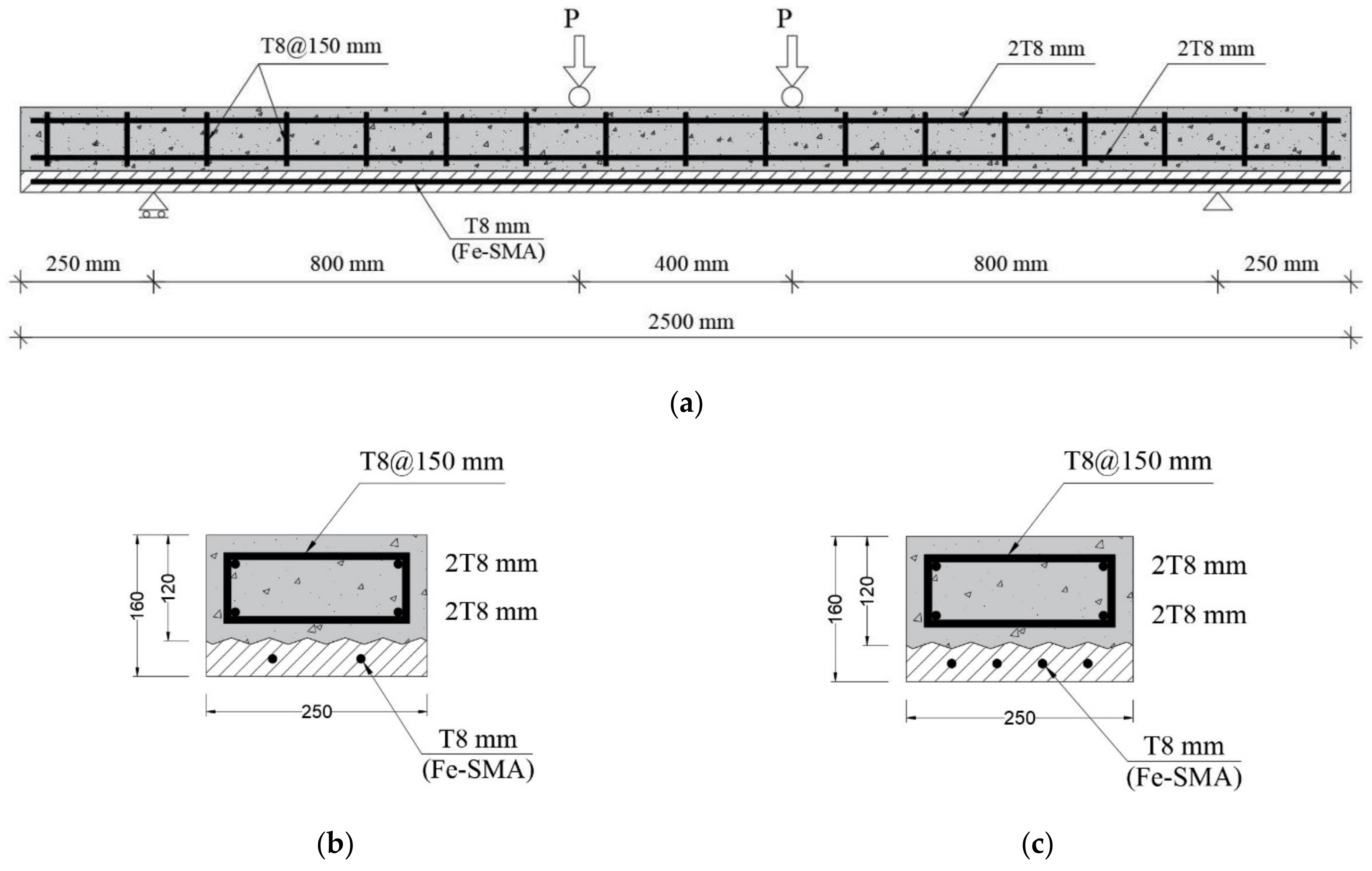
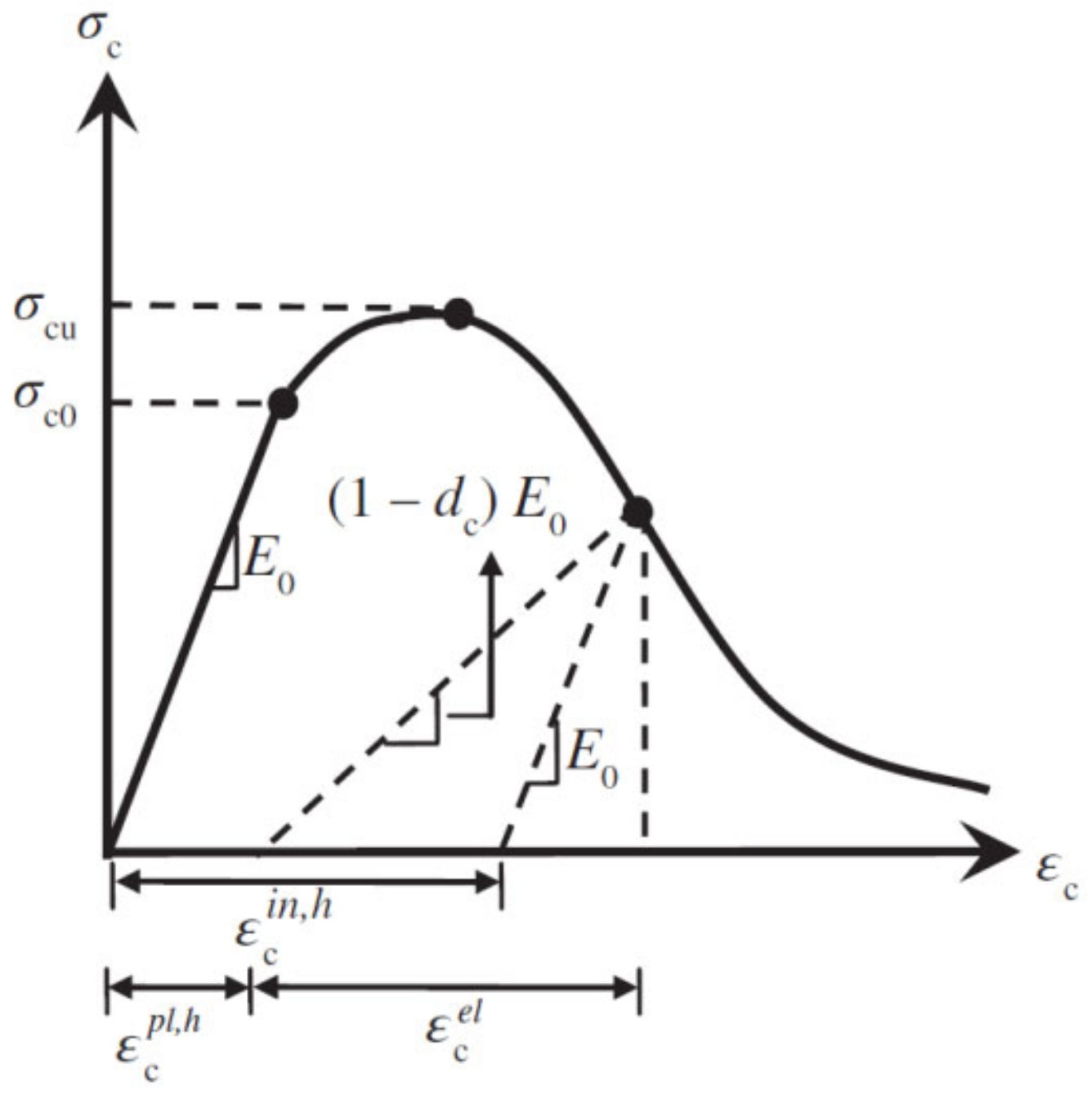
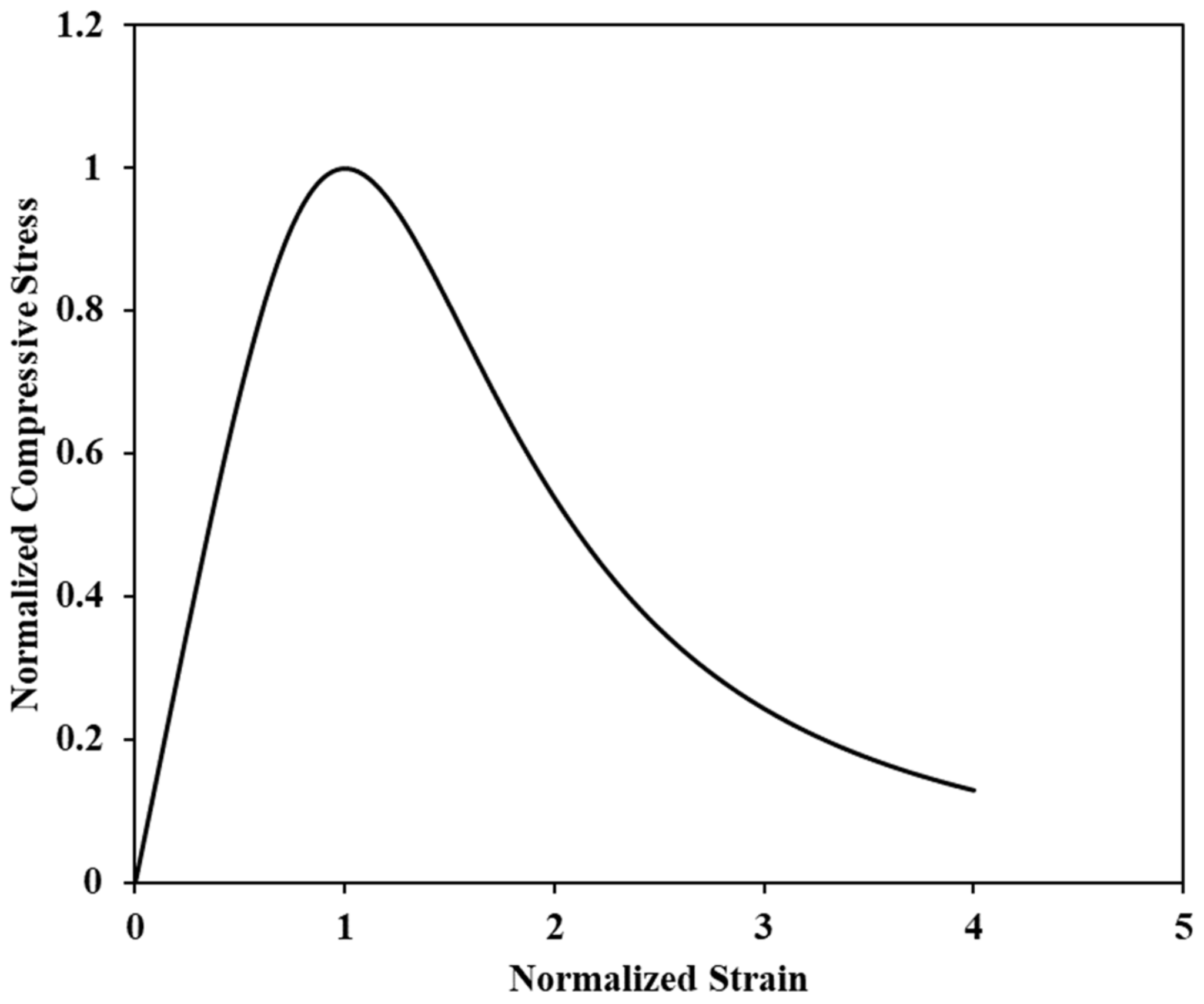
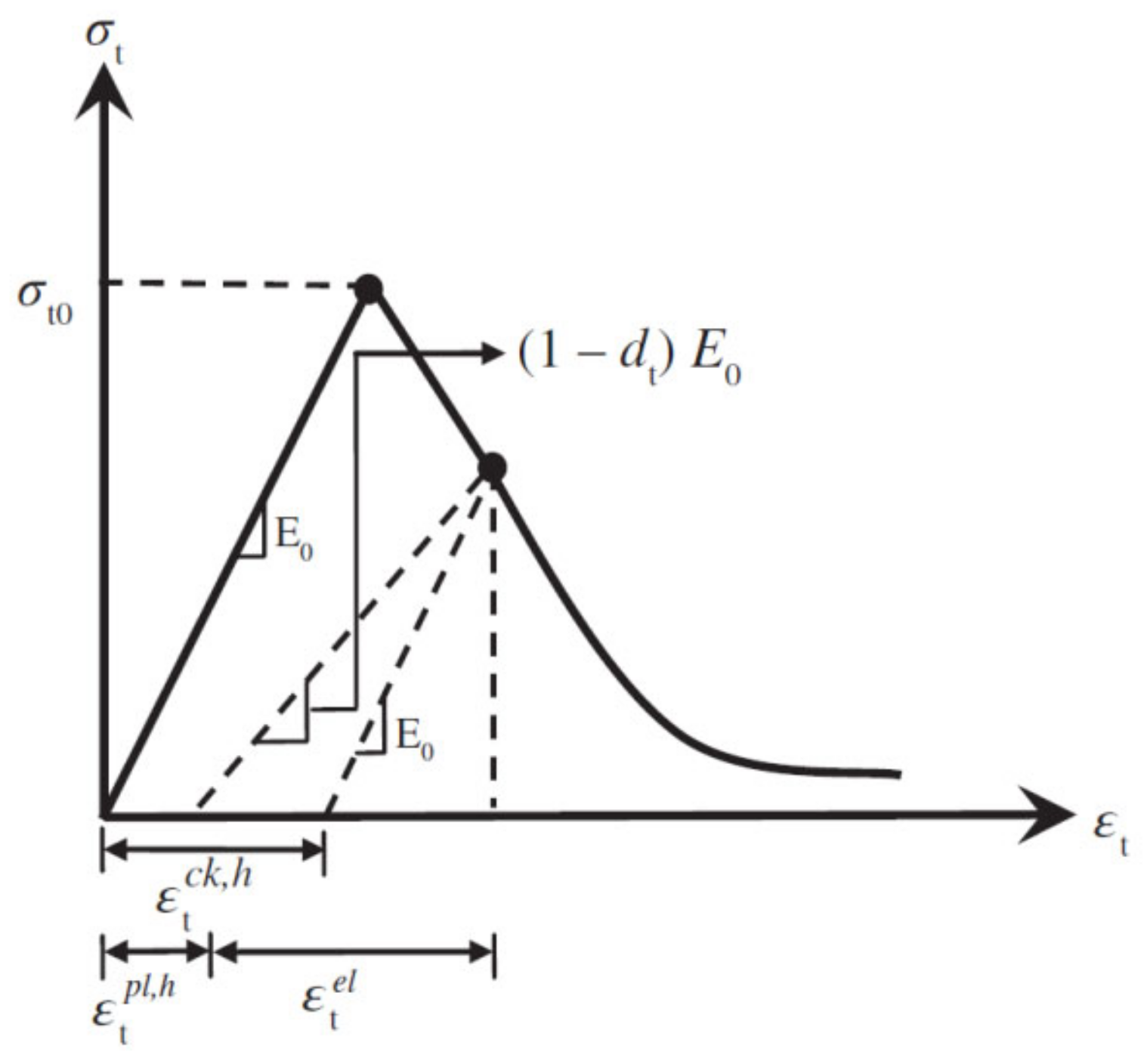
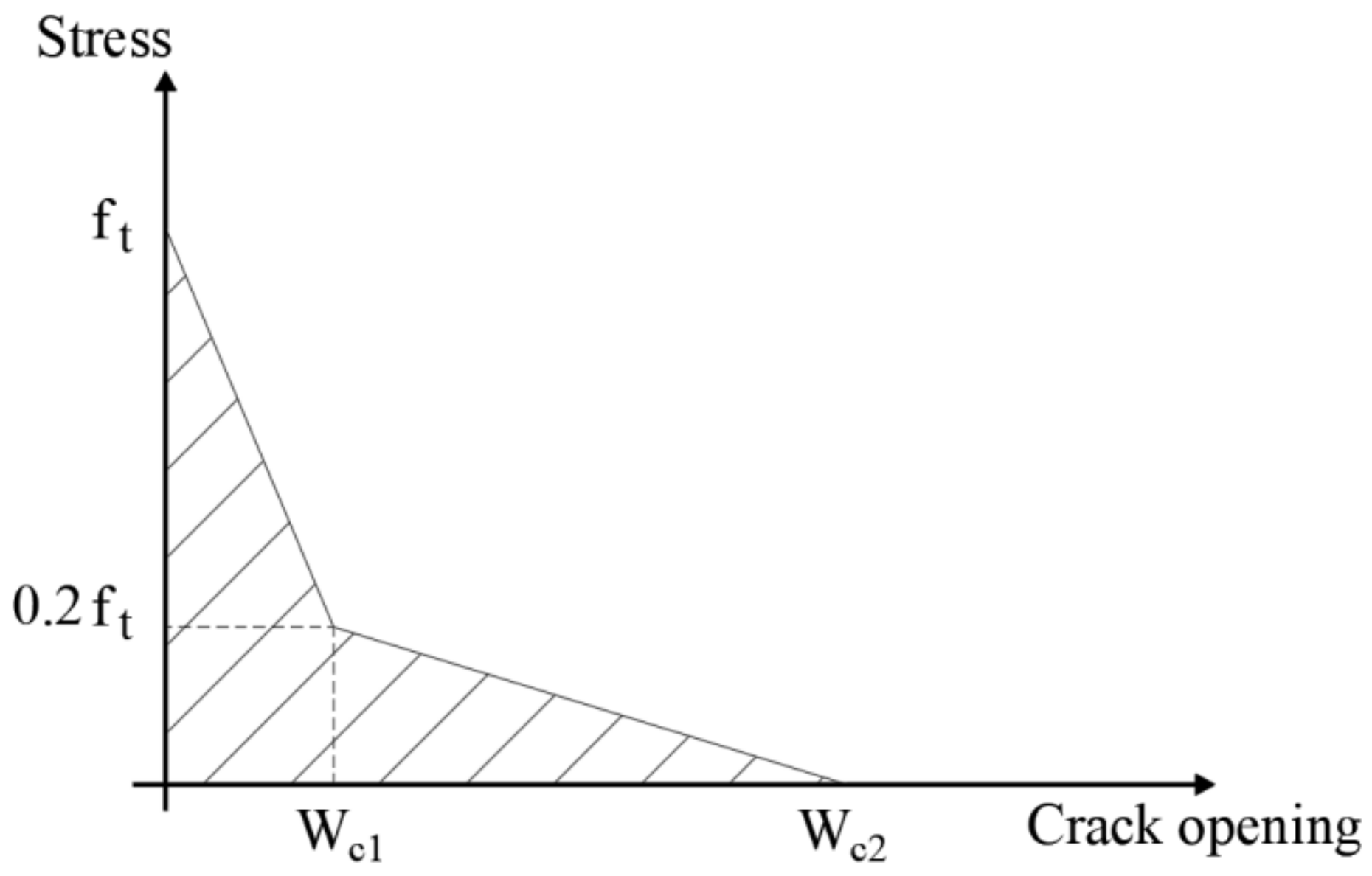
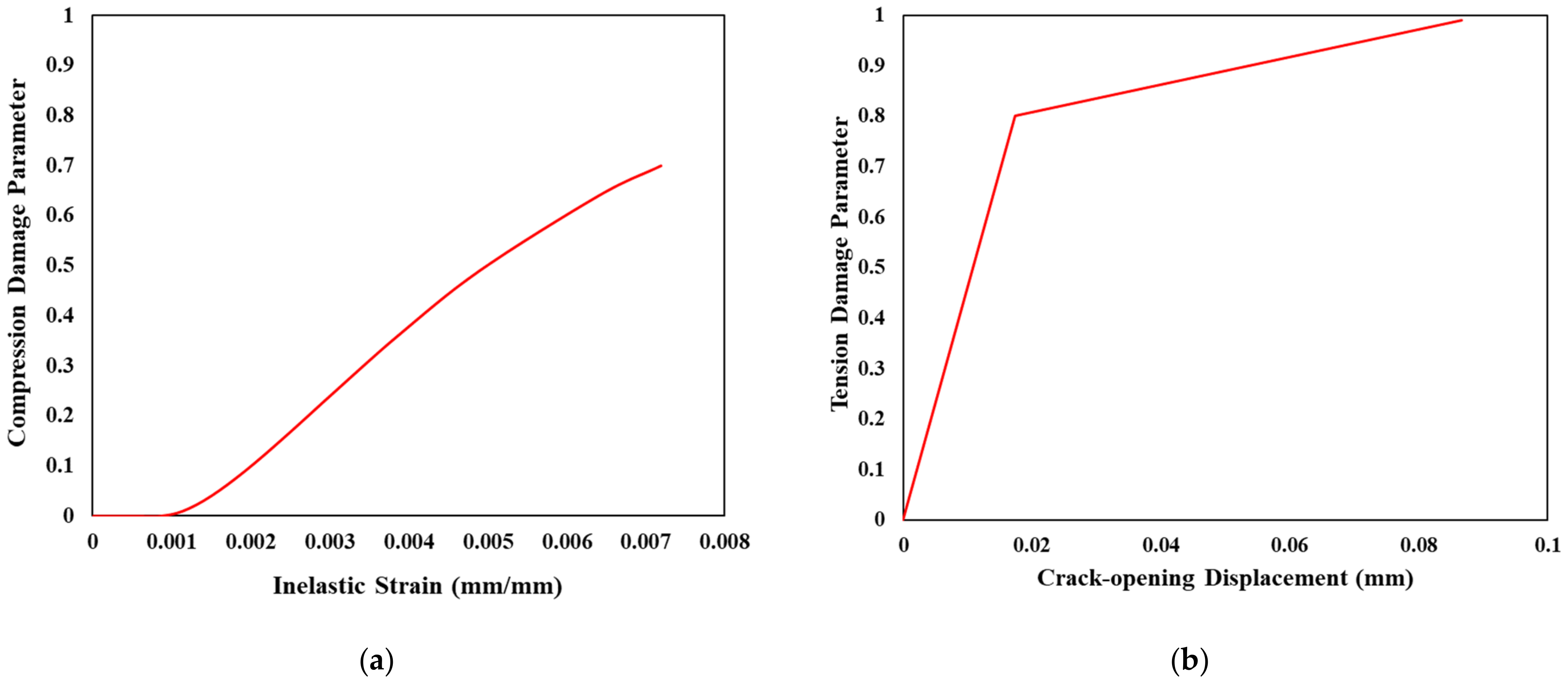
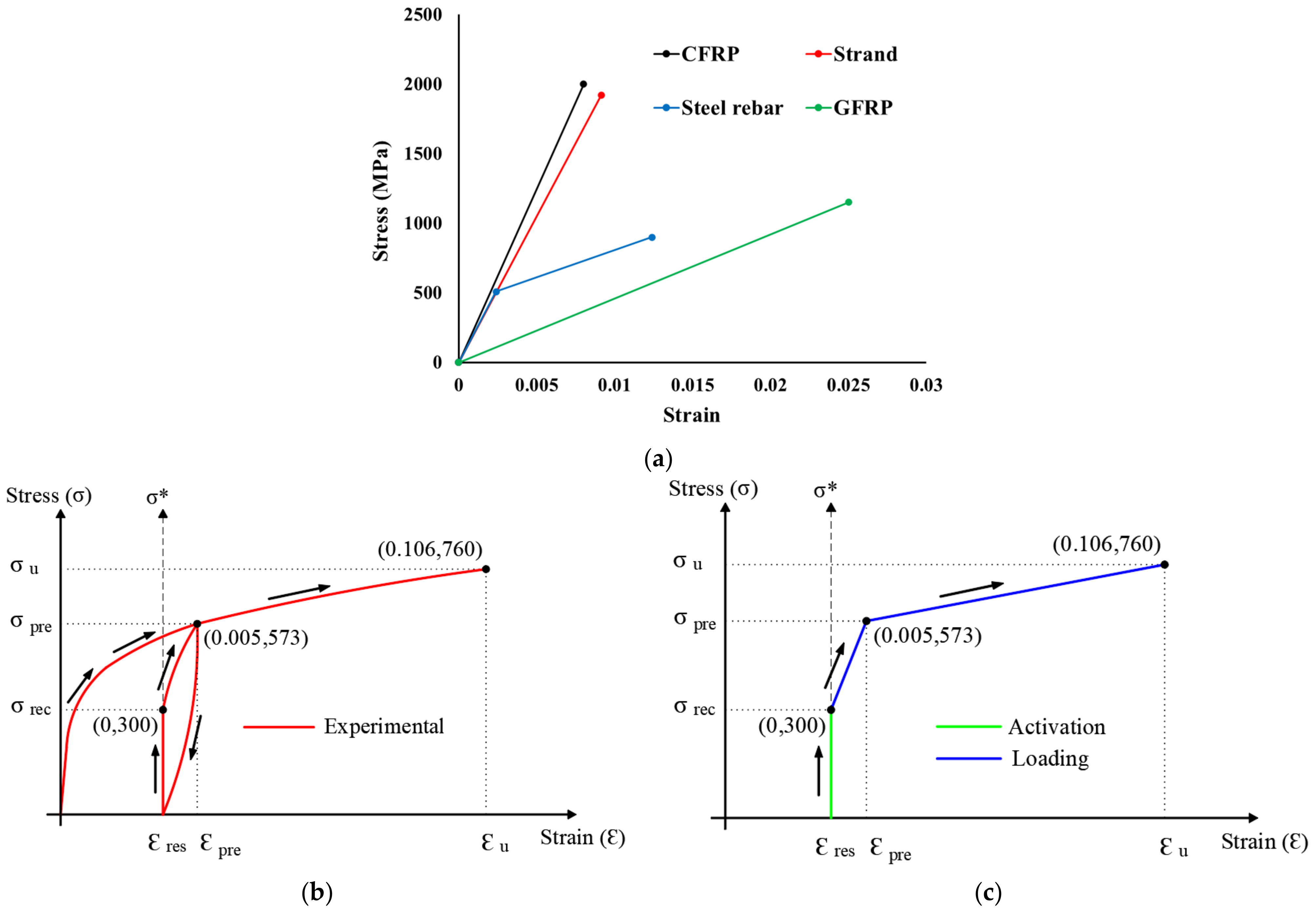
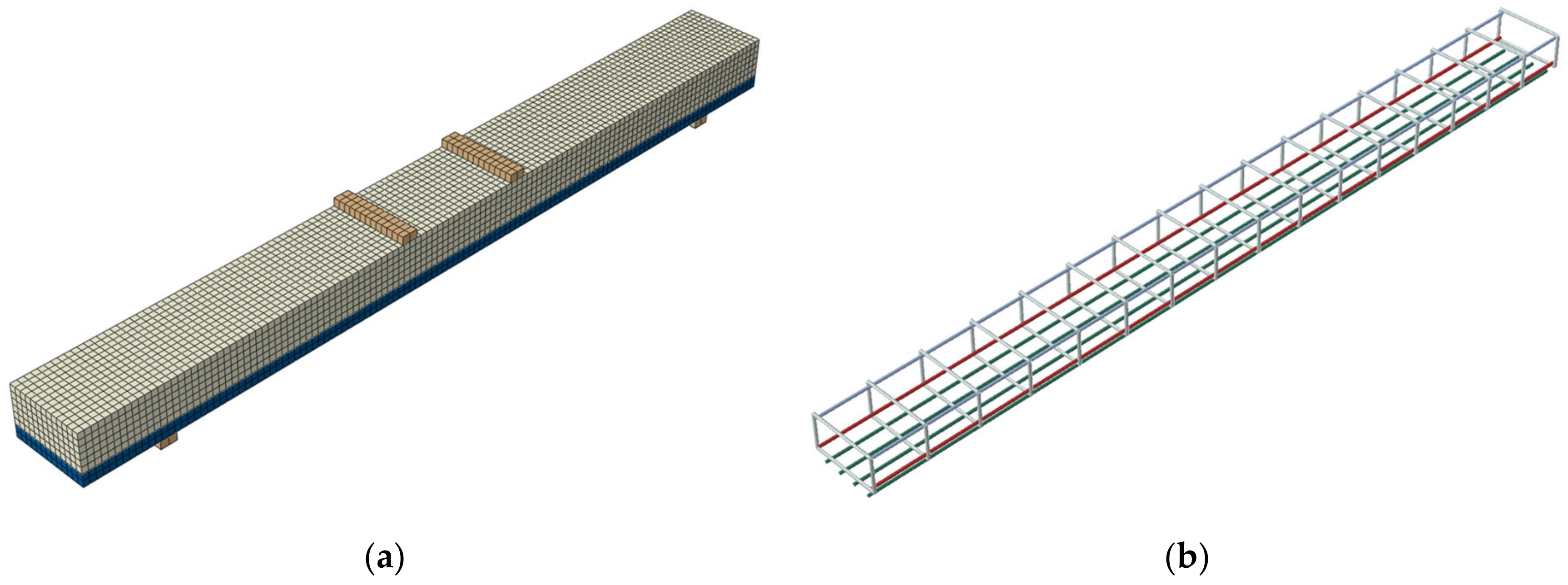

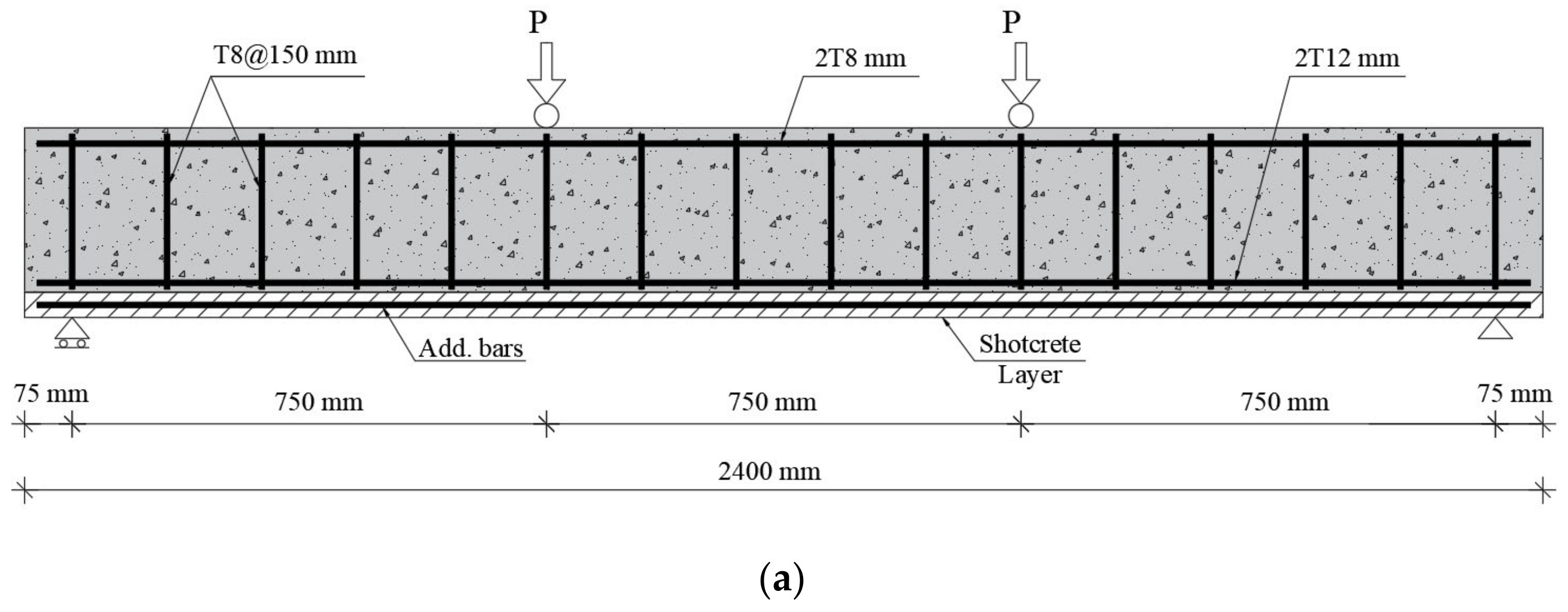
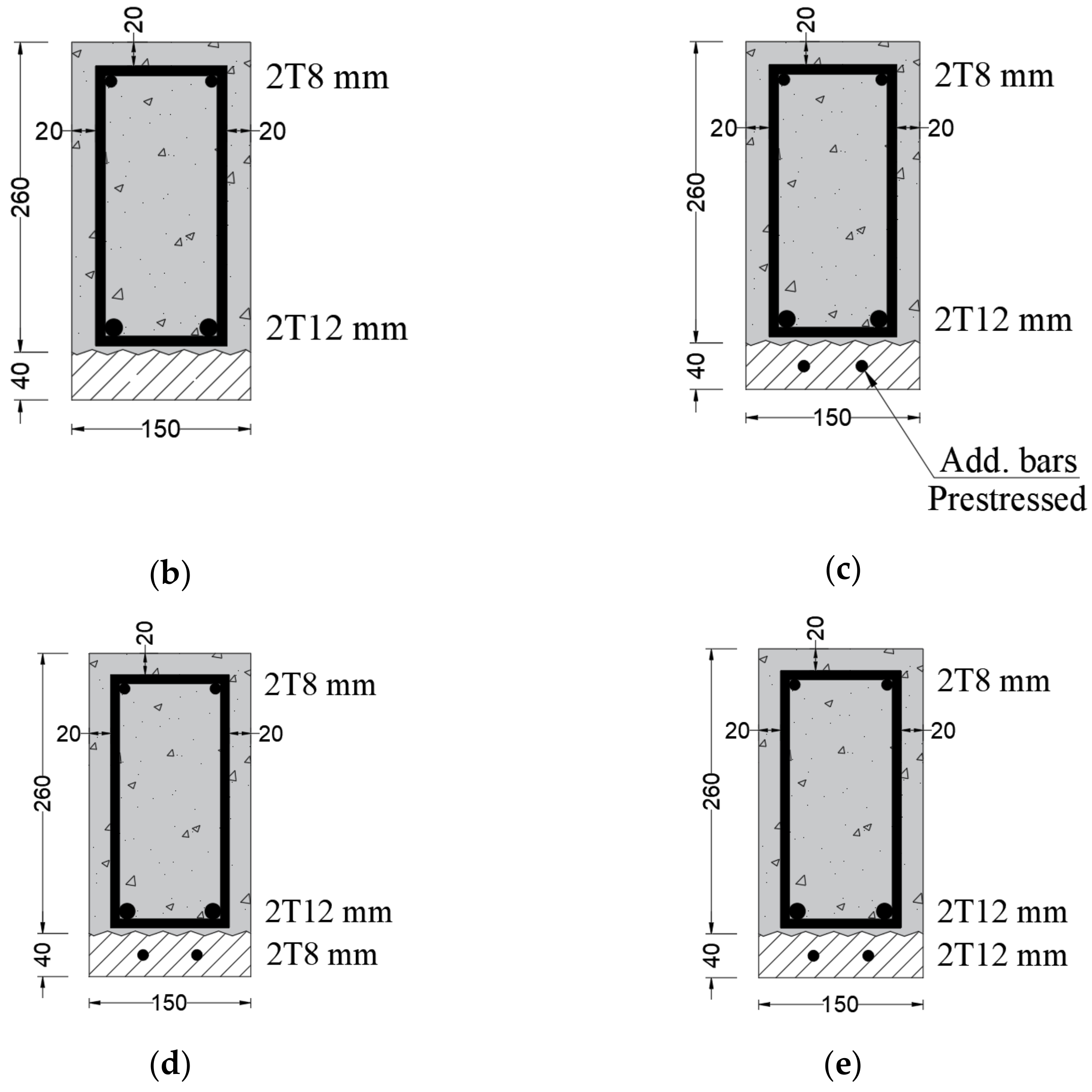

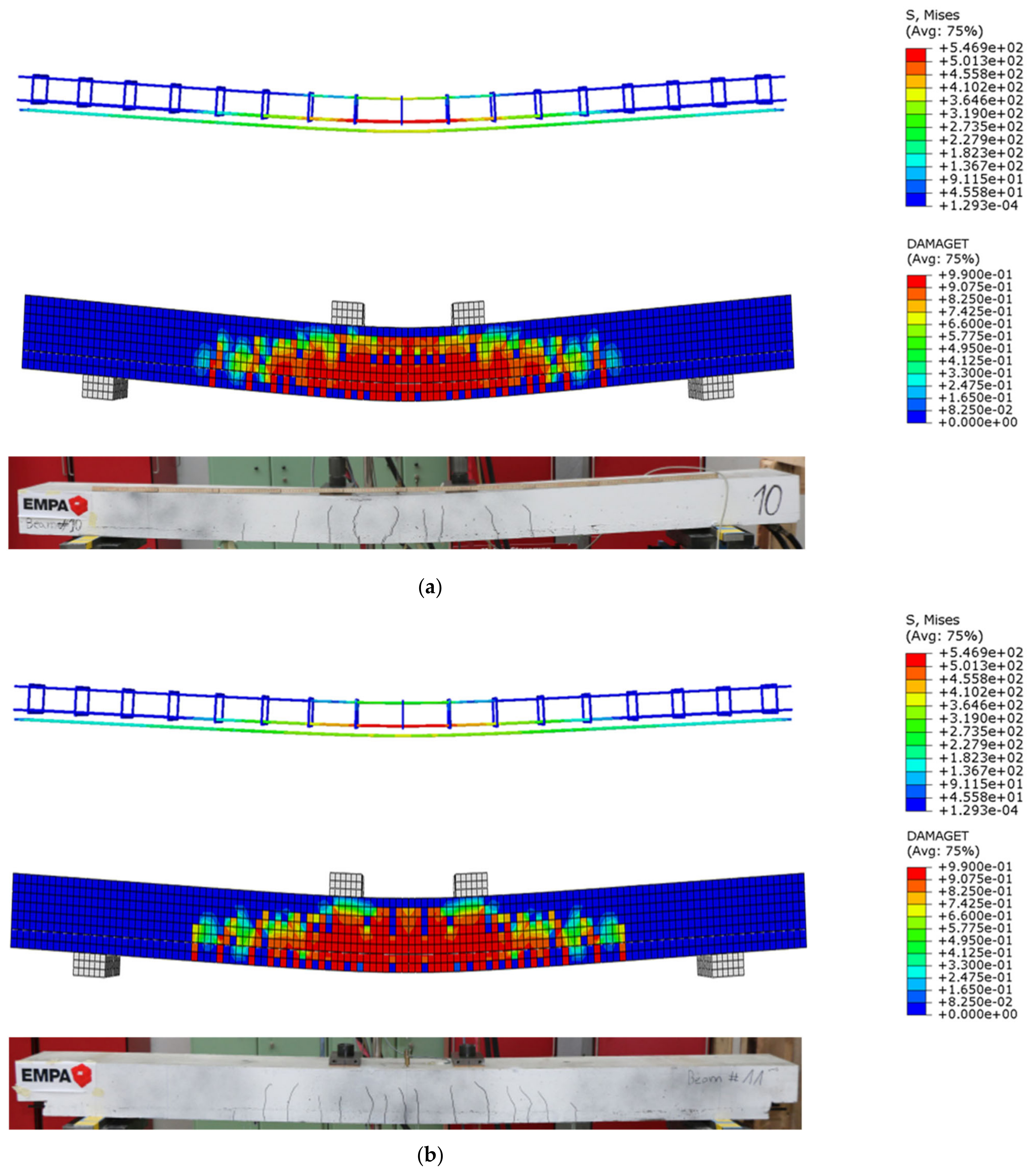
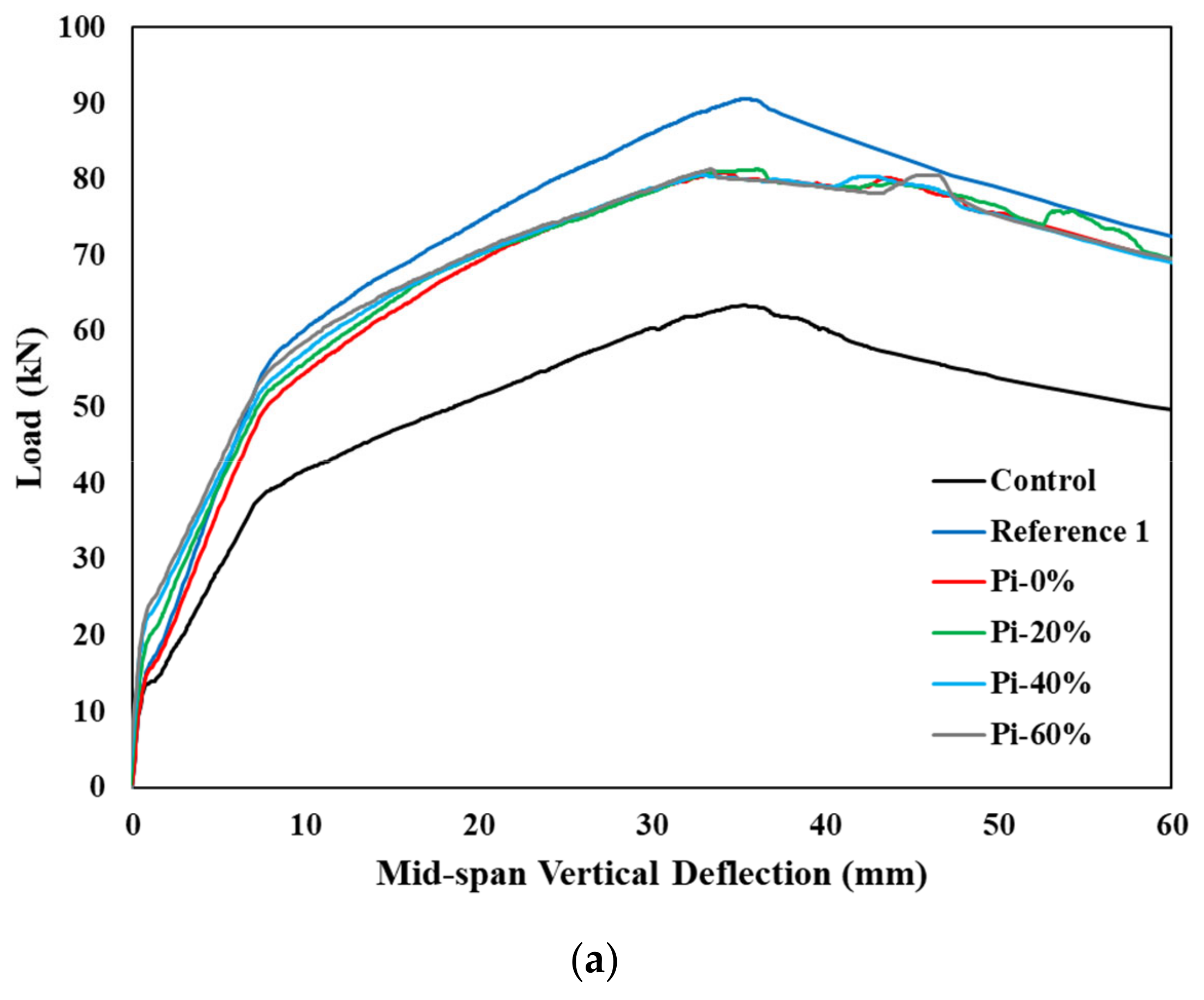
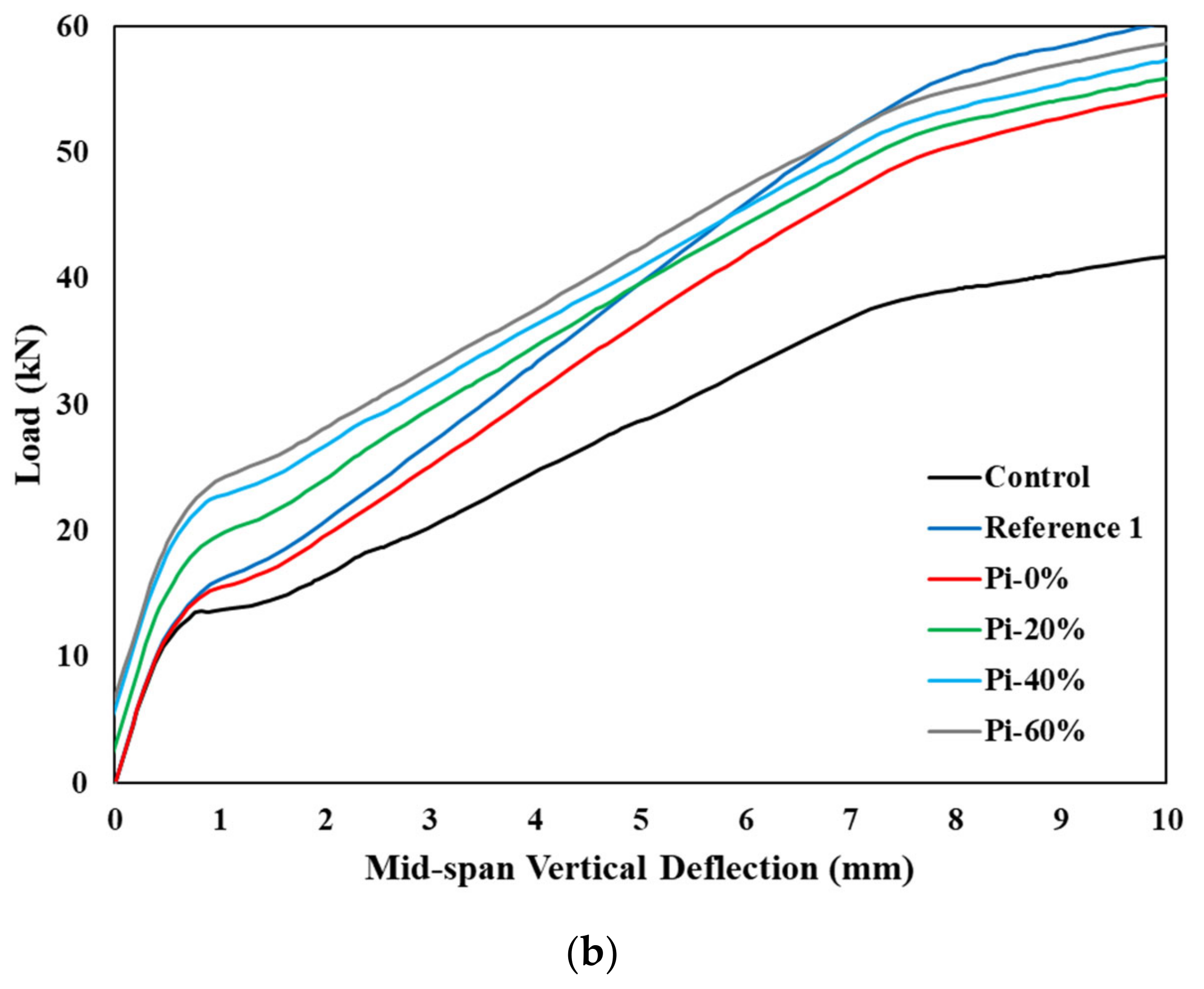
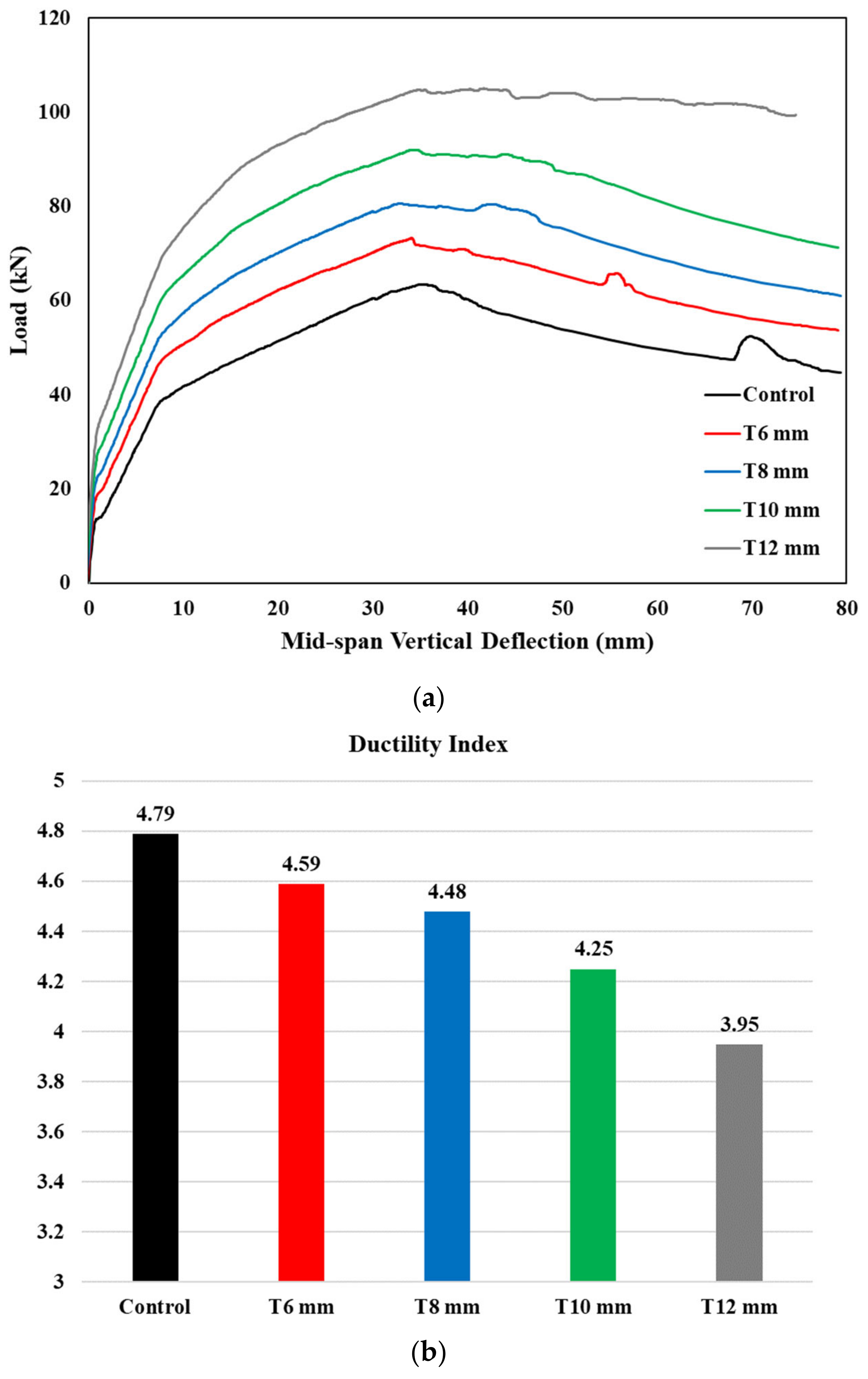


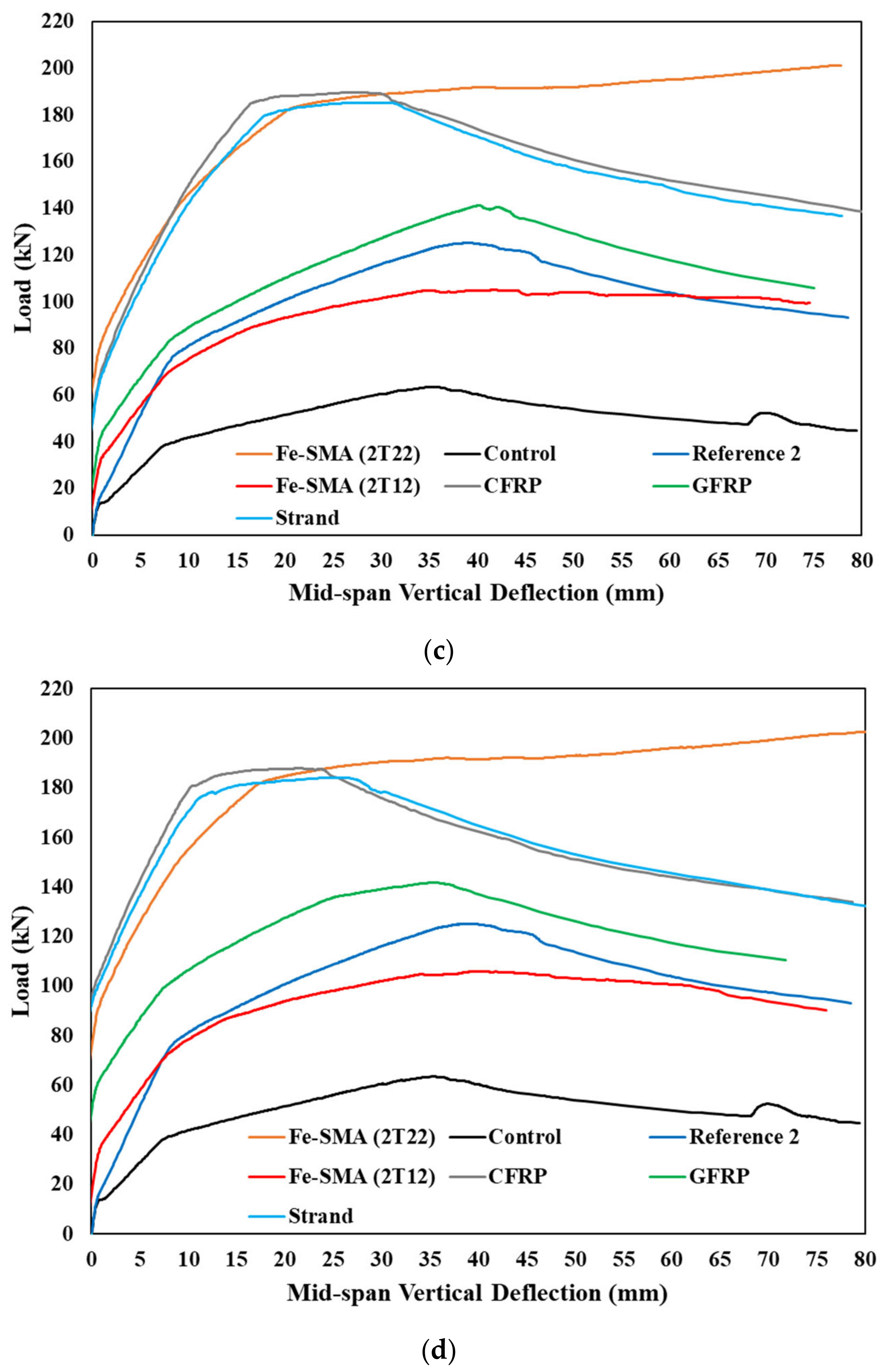
| Dilation Angle | Eccentricity (e) | fb0/fc0 | K | Viscosity Parameter |
|---|---|---|---|---|
| 55 | 0.1 | 1.16 | 0.67 | 0.0001 |
Publisher’s Note: MDPI stays neutral with regard to jurisdictional claims in published maps and institutional affiliations. |
© 2022 by the authors. Licensee MDPI, Basel, Switzerland. This article is an open access article distributed under the terms and conditions of the Creative Commons Attribution (CC BY) license (https://creativecommons.org/licenses/by/4.0/).
Share and Cite
Khalil, A.; Elkafrawy, M.; Abuzaid, W.; Hawileh, R.; AlHamaydeh, M. Flexural Performance of RC Beams Strengthened with Pre-Stressed Iron-Based Shape Memory Alloy (Fe-SMA) Bars: Numerical Study. Buildings 2022, 12, 2228. https://doi.org/10.3390/buildings12122228
Khalil A, Elkafrawy M, Abuzaid W, Hawileh R, AlHamaydeh M. Flexural Performance of RC Beams Strengthened with Pre-Stressed Iron-Based Shape Memory Alloy (Fe-SMA) Bars: Numerical Study. Buildings. 2022; 12(12):2228. https://doi.org/10.3390/buildings12122228
Chicago/Turabian StyleKhalil, Ahmed, Mohamed Elkafrawy, Wael Abuzaid, Rami Hawileh, and Mohammad AlHamaydeh. 2022. "Flexural Performance of RC Beams Strengthened with Pre-Stressed Iron-Based Shape Memory Alloy (Fe-SMA) Bars: Numerical Study" Buildings 12, no. 12: 2228. https://doi.org/10.3390/buildings12122228
APA StyleKhalil, A., Elkafrawy, M., Abuzaid, W., Hawileh, R., & AlHamaydeh, M. (2022). Flexural Performance of RC Beams Strengthened with Pre-Stressed Iron-Based Shape Memory Alloy (Fe-SMA) Bars: Numerical Study. Buildings, 12(12), 2228. https://doi.org/10.3390/buildings12122228











